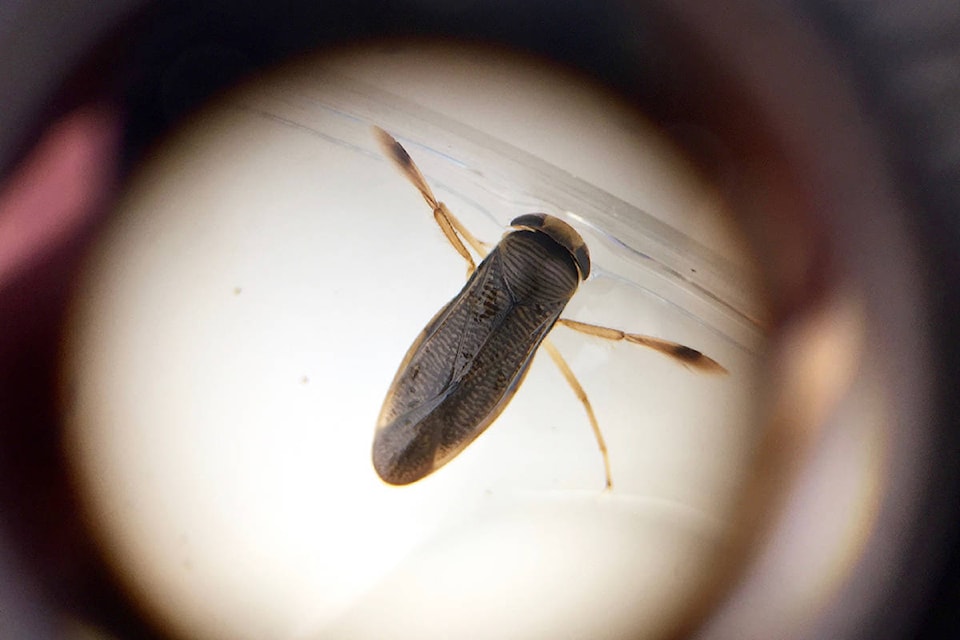On a mountain ridge above the Kluane Lake Research Station, Claudia Copley was flipping over stones on a cold day in late June and uncovered an animal that has never been spotted in the Yukon before.
The species of snail, Vallonia cyclophorella, is common in British Columbia but has never been seen in the territory until now, according to Yukon researchers.
Copley, the entomology collections manager and researcher with the Royal B.C. Museum, was expecting to find spiders. But during this rare trip to the Yukon she was collecting a little bit of everything she spotted.
“That’s the most likely thing to find, spiders. Then whatever else is under there comes into the collection too.”
Though potentially appearing insignificant to the untrained eye, for scientists the tiny snail is the latest discovery helping to understand biodiversity in the Yukon.
Over a weekend at the end of June more than 55 scientists and more than a dozen volunteers descended on Kluane National Park as part of a ‘bioblitz’, a concentrated effort to collect as much data and samples as possible about the plants and animals that live in the park.
“It’s just like a big grown-up treasure hunt,” said Syd Cannings, a species-at-risk biologist for the Canadian Wildlife Service and one of the event’s organizers.
The hunt was put on by the Yukon and federal governments in partnership with Kluane First Nation and Champagne and Aishihik First Nations.
Centred mainly around the Kluane Lake Research Station, the search area covered a circle about 30 kilometres in diameter. Some scientists stayed closer to the ground while others, like Copley, were flown by helicopter to heights harder to get to by foot.
Cannings said scientists like Copley know how uncommon it is to get samples from those locations so they try to collect as much as possible.
“She wouldn’t normally collect snails. But if she goes to a place like Kluane and gets flown up into a high mountain, she’ll collect everything because she knows that no one is going to go back there anytime soon,” Cannings said.
It’ll take time for experts to officially identify everything that has been collected. The snail wasn’t identified until Copley got back home and was able to show it to a colleague.
As of Aug. 1, experts estimate they collected 302 species of plants from that area of the park along with 14 that still need to be confirmed. That includes a a liverwort not seen since 1902. The samples represent about a quarter of plants known in the Yukon, Cannings said.
As for how many insects and other animals were identified, those numbers haven’t come in yet. It was a successful weekend, Cannings said. One person who was interested in butterflies and moths personally found 29 different species.
It’s not surprising that new or uncommon plants and animals were found in the area once people started taking a closer look, said Todd Powell, manager of the biodiveristy section of Environment Yukon’s fish and wildlife branch.
This is only the second time that experts have been brought in to do this kind of intensive search in the Yukon. Last year’s bioblitz was in Carmacks.
Powell estimates the territory has about 5,200 native plants and animals in its database but there are “easily another 10 to 20,000” that haven’t been found yet.
“With the number of species, and the variety of life on the planet, it just takes a long time to get a handle on that,” he said.
“We’re just at that point in our evolutionary stage that it still allows us a lot of opportunity to continue to look and discover new things.”
Along with uncovering new species, the Kluane bioblitz scientists were able to learn more about animals they already know are living in the park.
In 2010 Cannings found a species of bumblebee scientists had never seen before. The recently-named Bombus kluanensis is the first new bumblebee discovered in Canada and the U.S. in almost 90 years.
Cannings first spotted the species in two Yukon locations— once outside Kluane National Park and once inside the park.
During this year’s bioblitz the bee was seen in two or three more spots in the park, he said.
“That’s one of the reasons we wanted to go to Kluane, because it has these interesting species and we wanted to be able to locate them in more places than we knew of.”
Researchers also found seven caterpillars in the park belonging to a rare species of tiger moth, Cannings said.
“Before that, in the world, I think there were only four specimens known. We now know that it is more widespread and it must be reasonably common if we can find seven in one day.”
Cannings belongs to the national organization that labels species as endangered or at risk. Knowing how common a species is and how far its habitat spreads is important to that work, he said.
Sometimes something will be labelled at risk but once the time and money is put into researching the species it’s found to be much more common than people thought, he said.
“When we go to put species in the rare/endangered list for Canada, we don’t want to spend all the time and effort assessing things that aren’t that rare.”
The samples from the park will be going to various research collections and be available for scientists to study for years, Cannings said.
“It’s fun and you feel like you’re adding to human knowledge.”
Contact Ashley Joannou at ashleyj@yukon-news.com
